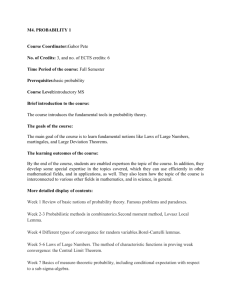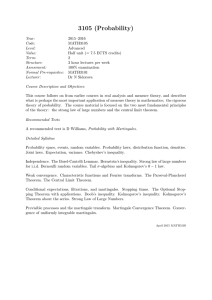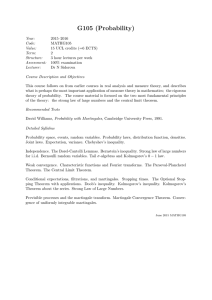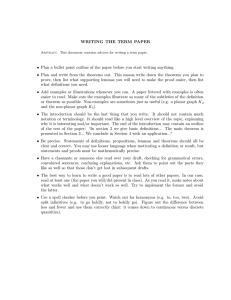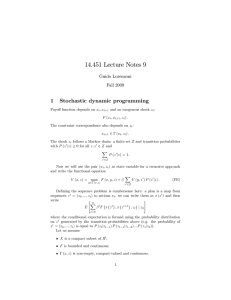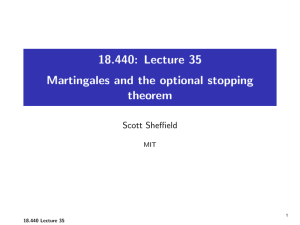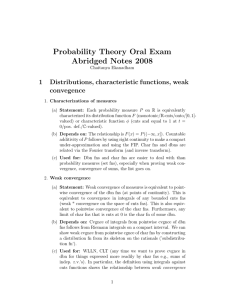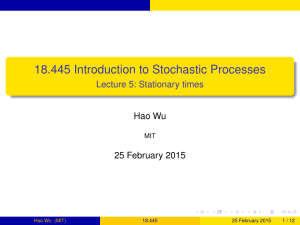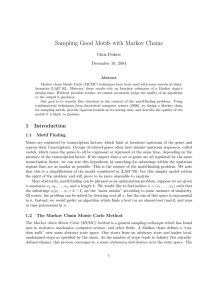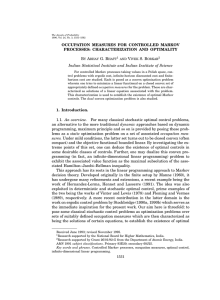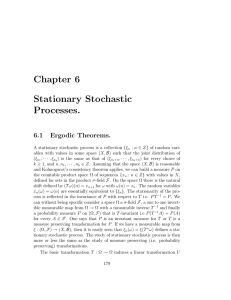Probability Theory S.R.S.Varadhan Courant Institute of Mathematical Sciences New York University
advertisement
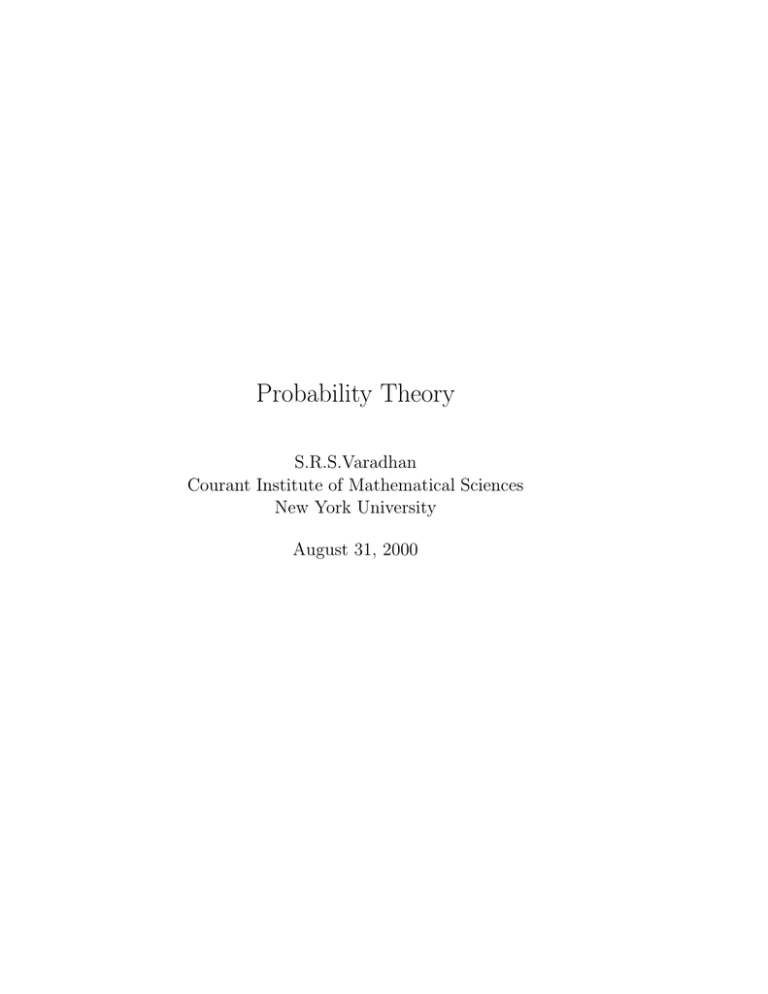
Probability Theory S.R.S.Varadhan Courant Institute of Mathematical Sciences New York University August 31, 2000 2 Contents 1 Measure Theory 1.1 Introduction. . . . . . . . . . . 1.2 Construction of Measures . . . 1.3 Integration . . . . . . . . . . . . 1.4 Transformations . . . . . . . . . 1.5 Product Spaces . . . . . . . . . 1.6 Distributions and Expectations . . . . . . 7 7 11 14 22 24 28 2 Weak Convergence 2.1 Characteristic Functions . . . . . . . . . . . . . . . . . . . . . 2.2 Moment Generating Functions . . . . . . . . . . . . . . . . . . 2.3 Weak Convergence . . . . . . . . . . . . . . . . . . . . . . . . 31 31 36 38 3 Independent Sums 3.1 Independence and Convolution . . . . . . 3.2 Weak Law of Large Numbers . . . . . . . 3.3 Strong Limit Theorems . . . . . . . . . . 3.4 Series of Independent Random variables 3.5 Strong Law of Large Numbers . . . . . . 3.6 Central Limit Theorem. . . . . . . . . . 3.7 Accompanying Laws. . . . . . . . . . . . 3.8 Infinitely Divisible Distributions. . . . . 3.9 Laws of the iterated logarithm. . . . . . 51 51 54 58 61 68 70 76 83 92 . . . . . . . . . . . . . . . . . . . . . . . . . . . . . . . . . . . . . . . . . . . . . . . . . . . . . . . . . . . . . . . . . . . . . . . . . . . . . . . . . . . . . . . . . . . . . . . . . . . . . . . . . . . . . . . . . . . . . . . . . . . . . . . . . . . . . . . . . . . . . . . . . . . . . . . . . . . . . . . . . . . . . . . . . . . . . . . . . . . . . . . . . . . . . . . . . . . . . . . . . . . . 4 Dependent Random Variables 101 4.1 Conditioning . . . . . . . . . . . . . . . . . . . . . . . . . . . 101 4.2 Conditional Expectation . . . . . . . . . . . . . . . . . . . . . 108 4.3 Conditional Probability . . . . . . . . . . . . . . . . . . . . . . 112 3 CONTENTS 4 4.4 Markov Chains . . . . . . . . . . . . . . . . . . . . . . . . . . 116 4.5 Stopping Times and Renewal Times . . . . . . . . . . . . . . . 122 4.6 Countable State Space . . . . . . . . . . . . . . . . . . . . . . 123 5 Martingales. 5.1 Definitions and properties . . . . . . . 5.2 Martingale Convergence Theorems. . . 5.3 Doob Decomposition Theorem. . . . . 5.4 Stopping Times. . . . . . . . . . . . . . 5.5 Upcrossing Inequality. . . . . . . . . . 5.6 Martingale Transforms, Option Pricing. 5.7 Martingales and Markov Chains. . . . . . . . . . . 149 . 149 . 154 . 157 . 160 . 164 . 165 . 169 . . . . . . 179 . 179 . 184 . 187 . 192 . 195 . 199 Filtering. . . . . . . . . . . . . . . . . . . . . . . . . . . . . . . . . . . . . . . . . . . . . . . . . . . . . . . . . . 213 . 213 . 215 . 218 . . . . . . . 6 Stationary Stochastic Processes. 6.1 Ergodic Theorems. . . . . . . . . . . . . 6.2 Structure of Stationary Measures. . . . . 6.3 Stationary Markov Processes. . . . . . . 6.4 Mixing properties of Markov Processes. . 6.5 Central Limit Theorem for Martingales. 6.6 Stationary Gaussian Processes. . . . . . 7 Dynamic Programming 7.1 Optimal Control. . . 7.2 Optimal Stopping. . 7.3 Filtering. . . . . . . . and . . . . . . . . . . . . . . . . . . . . . . . . . . . . . . . . . . . . . . . . . . . . . . . . . . . . . . . . . . . . . . . . . . . . . . . . . . . . . . . . . . . . . . . . . . . . . . . . . . . . . . . . . . . . . . . . . . . . . . . . . . . . . . . . . . . . . . . . . . . Preface These notes are based on a first year graduate course on Probability and Limit theorems given at Courant Institute of Mathematical Sciences. Originally written during 1997-98, they have been revised during academic year 199899 as well as in the Fall of 1999. I want to express my appreciation to those who pointed out to me several typos as well as suggestions for improvement. I want to mention in particular the detailed comments from Professor Charles Newman and Mr Enrique Loubet. Chuck used it while teaching the course in 98-99 and Enrique helped me as TA when I taught out of these notes again in the Fall of 99. These notes cover about three fourths of the course, essentially discrete time processes. Hopefully there will appear a companion volume some time in the near future that will cover continuos time processes. A small amount measure theory that is included. While it is not meant to be complete, it is my hope that it will be useful. 5 6 CONTENTS
